Essay: Analysis of the Australian Budget 2019-20 and Welfare Law
VerifiedAdded on 2022/10/04
|8
|1924
|439
Essay
AI Summary
This essay analyzes the Australian Budget of 2019-20, focusing on key strategies and their impact on the welfare system. The essay identifies strategies such as tax relief for low and middle-income earners, infrastructure spending, and investments in healthcare and education as strong points supporting welfare. It also discusses the application of Laissez-Faire economics in the budget's tax policies. The essay provides a detailed overview of the budget's initiatives, including reduced tax rates for businesses, increased spending on infrastructure, and continued investment in essential services like Medicare and aged care. The analysis concludes that the budget, overall, positively impacts the welfare of Australian citizens, while also acknowledging certain areas for improvement, and the application of Laissez-Faire economics in the budget's approach to welfare.
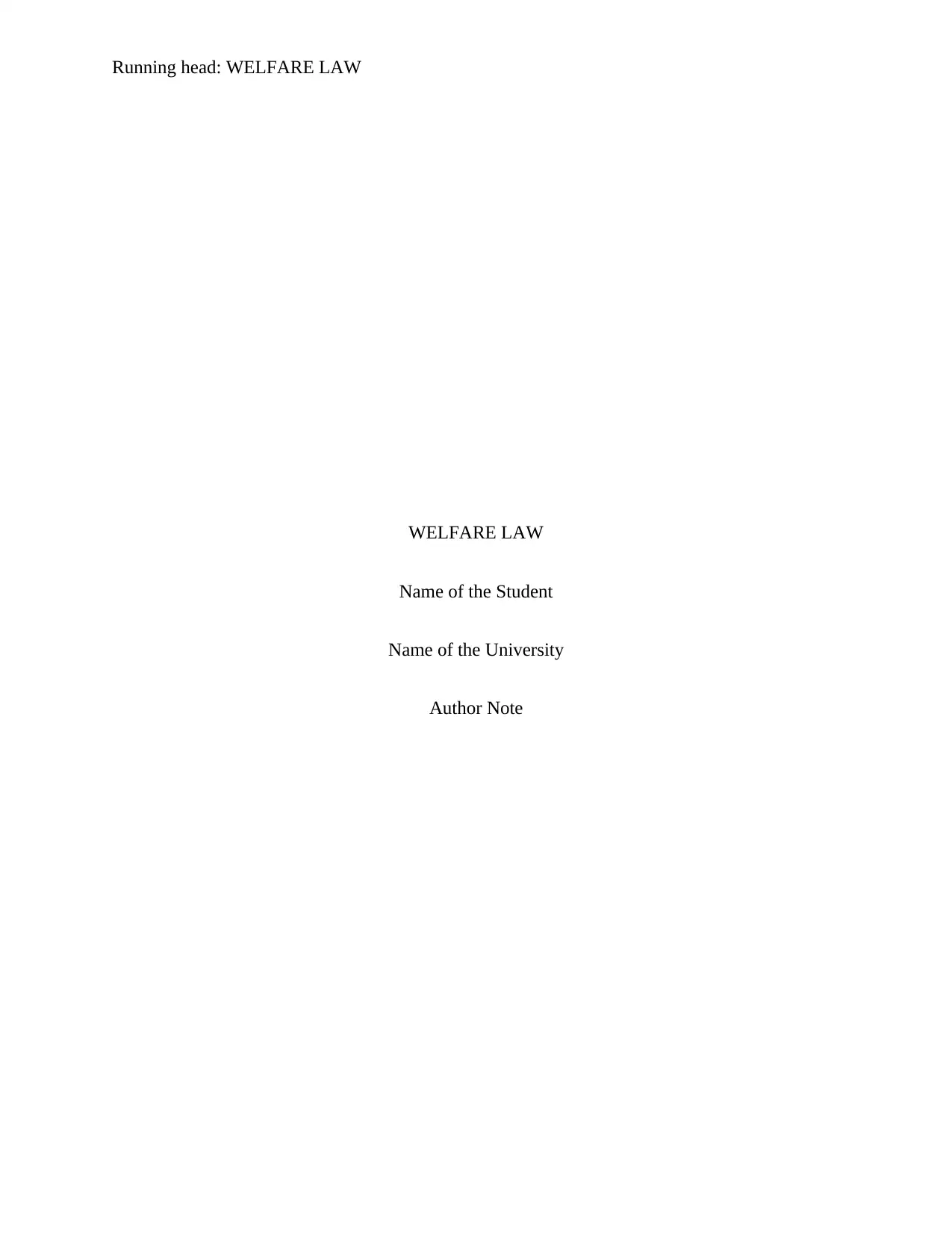
Running head: WELFARE LAW
WELFARE LAW
Name of the Student
Name of the University
Author Note
WELFARE LAW
Name of the Student
Name of the University
Author Note
Paraphrase This Document
Need a fresh take? Get an instant paraphrase of this document with our AI Paraphraser
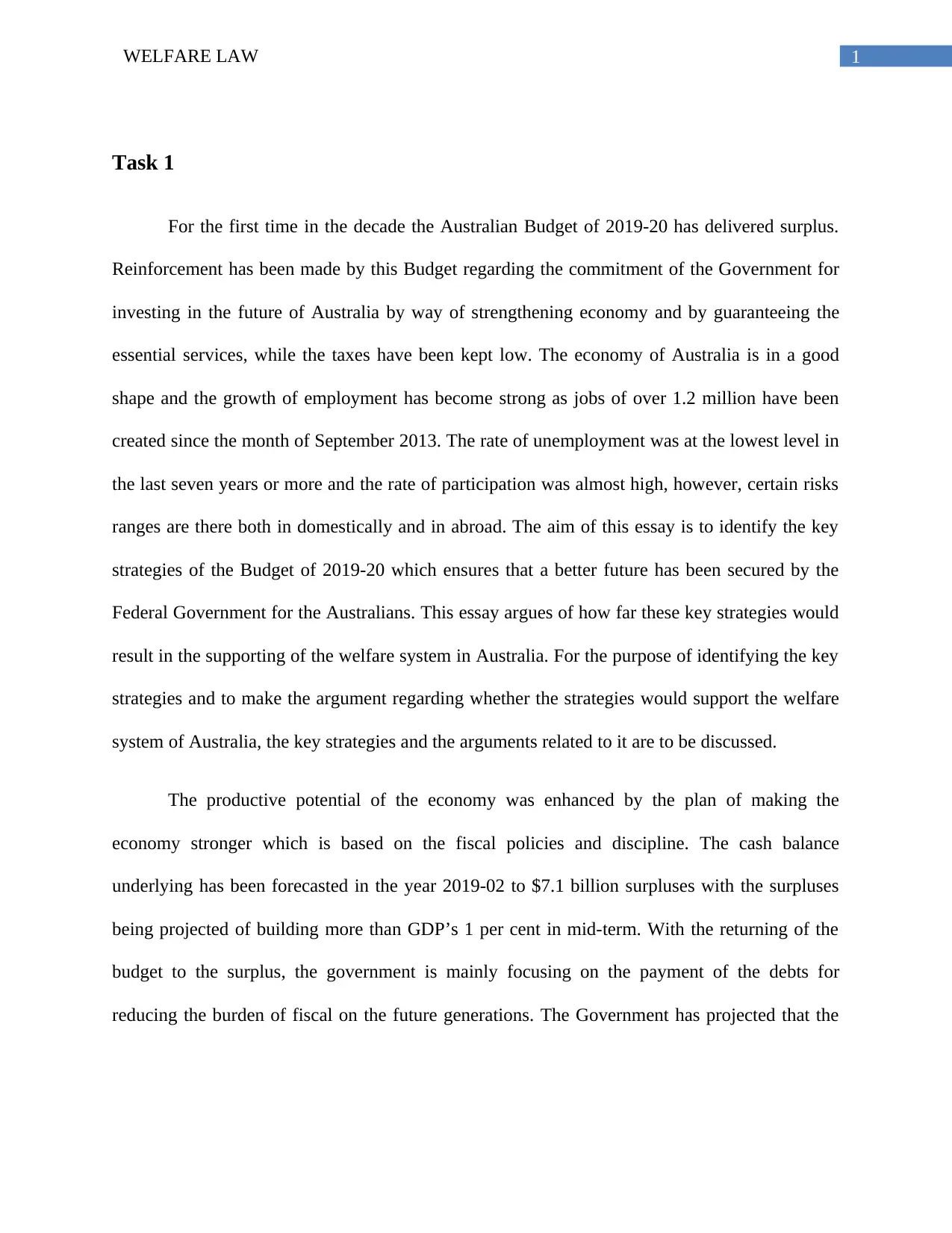
1WELFARE LAW
Task 1
For the first time in the decade the Australian Budget of 2019-20 has delivered surplus.
Reinforcement has been made by this Budget regarding the commitment of the Government for
investing in the future of Australia by way of strengthening economy and by guaranteeing the
essential services, while the taxes have been kept low. The economy of Australia is in a good
shape and the growth of employment has become strong as jobs of over 1.2 million have been
created since the month of September 2013. The rate of unemployment was at the lowest level in
the last seven years or more and the rate of participation was almost high, however, certain risks
ranges are there both in domestically and in abroad. The aim of this essay is to identify the key
strategies of the Budget of 2019-20 which ensures that a better future has been secured by the
Federal Government for the Australians. This essay argues of how far these key strategies would
result in the supporting of the welfare system in Australia. For the purpose of identifying the key
strategies and to make the argument regarding whether the strategies would support the welfare
system of Australia, the key strategies and the arguments related to it are to be discussed.
The productive potential of the economy was enhanced by the plan of making the
economy stronger which is based on the fiscal policies and discipline. The cash balance
underlying has been forecasted in the year 2019-02 to $7.1 billion surpluses with the surpluses
being projected of building more than GDP’s 1 per cent in mid-term. With the returning of the
budget to the surplus, the government is mainly focusing on the payment of the debts for
reducing the burden of fiscal on the future generations. The Government has projected that the
Task 1
For the first time in the decade the Australian Budget of 2019-20 has delivered surplus.
Reinforcement has been made by this Budget regarding the commitment of the Government for
investing in the future of Australia by way of strengthening economy and by guaranteeing the
essential services, while the taxes have been kept low. The economy of Australia is in a good
shape and the growth of employment has become strong as jobs of over 1.2 million have been
created since the month of September 2013. The rate of unemployment was at the lowest level in
the last seven years or more and the rate of participation was almost high, however, certain risks
ranges are there both in domestically and in abroad. The aim of this essay is to identify the key
strategies of the Budget of 2019-20 which ensures that a better future has been secured by the
Federal Government for the Australians. This essay argues of how far these key strategies would
result in the supporting of the welfare system in Australia. For the purpose of identifying the key
strategies and to make the argument regarding whether the strategies would support the welfare
system of Australia, the key strategies and the arguments related to it are to be discussed.
The productive potential of the economy was enhanced by the plan of making the
economy stronger which is based on the fiscal policies and discipline. The cash balance
underlying has been forecasted in the year 2019-02 to $7.1 billion surpluses with the surpluses
being projected of building more than GDP’s 1 per cent in mid-term. With the returning of the
budget to the surplus, the government is mainly focusing on the payment of the debts for
reducing the burden of fiscal on the future generations. The Government has projected that the
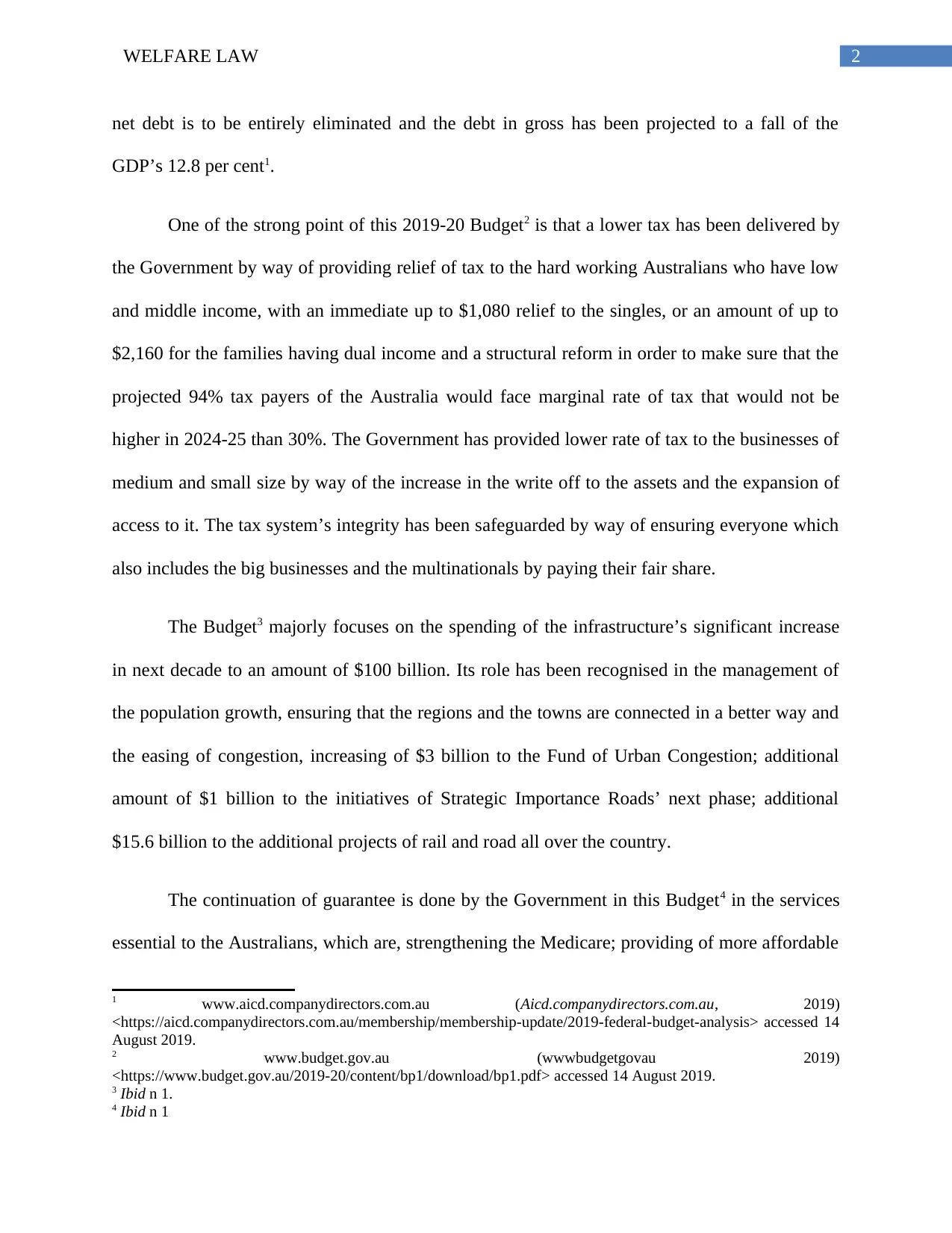
2WELFARE LAW
net debt is to be entirely eliminated and the debt in gross has been projected to a fall of the
GDP’s 12.8 per cent1.
One of the strong point of this 2019-20 Budget2 is that a lower tax has been delivered by
the Government by way of providing relief of tax to the hard working Australians who have low
and middle income, with an immediate up to $1,080 relief to the singles, or an amount of up to
$2,160 for the families having dual income and a structural reform in order to make sure that the
projected 94% tax payers of the Australia would face marginal rate of tax that would not be
higher in 2024-25 than 30%. The Government has provided lower rate of tax to the businesses of
medium and small size by way of the increase in the write off to the assets and the expansion of
access to it. The tax system’s integrity has been safeguarded by way of ensuring everyone which
also includes the big businesses and the multinationals by paying their fair share.
The Budget3 majorly focuses on the spending of the infrastructure’s significant increase
in next decade to an amount of $100 billion. Its role has been recognised in the management of
the population growth, ensuring that the regions and the towns are connected in a better way and
the easing of congestion, increasing of $3 billion to the Fund of Urban Congestion; additional
amount of $1 billion to the initiatives of Strategic Importance Roads’ next phase; additional
$15.6 billion to the additional projects of rail and road all over the country.
The continuation of guarantee is done by the Government in this Budget4 in the services
essential to the Australians, which are, strengthening the Medicare; providing of more affordable
1 www.aicd.companydirectors.com.au (Aicd.companydirectors.com.au, 2019)
<https://aicd.companydirectors.com.au/membership/membership-update/2019-federal-budget-analysis> accessed 14
August 2019.
2 www.budget.gov.au (wwwbudgetgovau 2019)
<https://www.budget.gov.au/2019-20/content/bp1/download/bp1.pdf> accessed 14 August 2019.
3 Ibid n 1.
4 Ibid n 1
net debt is to be entirely eliminated and the debt in gross has been projected to a fall of the
GDP’s 12.8 per cent1.
One of the strong point of this 2019-20 Budget2 is that a lower tax has been delivered by
the Government by way of providing relief of tax to the hard working Australians who have low
and middle income, with an immediate up to $1,080 relief to the singles, or an amount of up to
$2,160 for the families having dual income and a structural reform in order to make sure that the
projected 94% tax payers of the Australia would face marginal rate of tax that would not be
higher in 2024-25 than 30%. The Government has provided lower rate of tax to the businesses of
medium and small size by way of the increase in the write off to the assets and the expansion of
access to it. The tax system’s integrity has been safeguarded by way of ensuring everyone which
also includes the big businesses and the multinationals by paying their fair share.
The Budget3 majorly focuses on the spending of the infrastructure’s significant increase
in next decade to an amount of $100 billion. Its role has been recognised in the management of
the population growth, ensuring that the regions and the towns are connected in a better way and
the easing of congestion, increasing of $3 billion to the Fund of Urban Congestion; additional
amount of $1 billion to the initiatives of Strategic Importance Roads’ next phase; additional
$15.6 billion to the additional projects of rail and road all over the country.
The continuation of guarantee is done by the Government in this Budget4 in the services
essential to the Australians, which are, strengthening the Medicare; providing of more affordable
1 www.aicd.companydirectors.com.au (Aicd.companydirectors.com.au, 2019)
<https://aicd.companydirectors.com.au/membership/membership-update/2019-federal-budget-analysis> accessed 14
August 2019.
2 www.budget.gov.au (wwwbudgetgovau 2019)
<https://www.budget.gov.au/2019-20/content/bp1/download/bp1.pdf> accessed 14 August 2019.
3 Ibid n 1.
4 Ibid n 1
⊘ This is a preview!⊘
Do you want full access?
Subscribe today to unlock all pages.

Trusted by 1+ million students worldwide
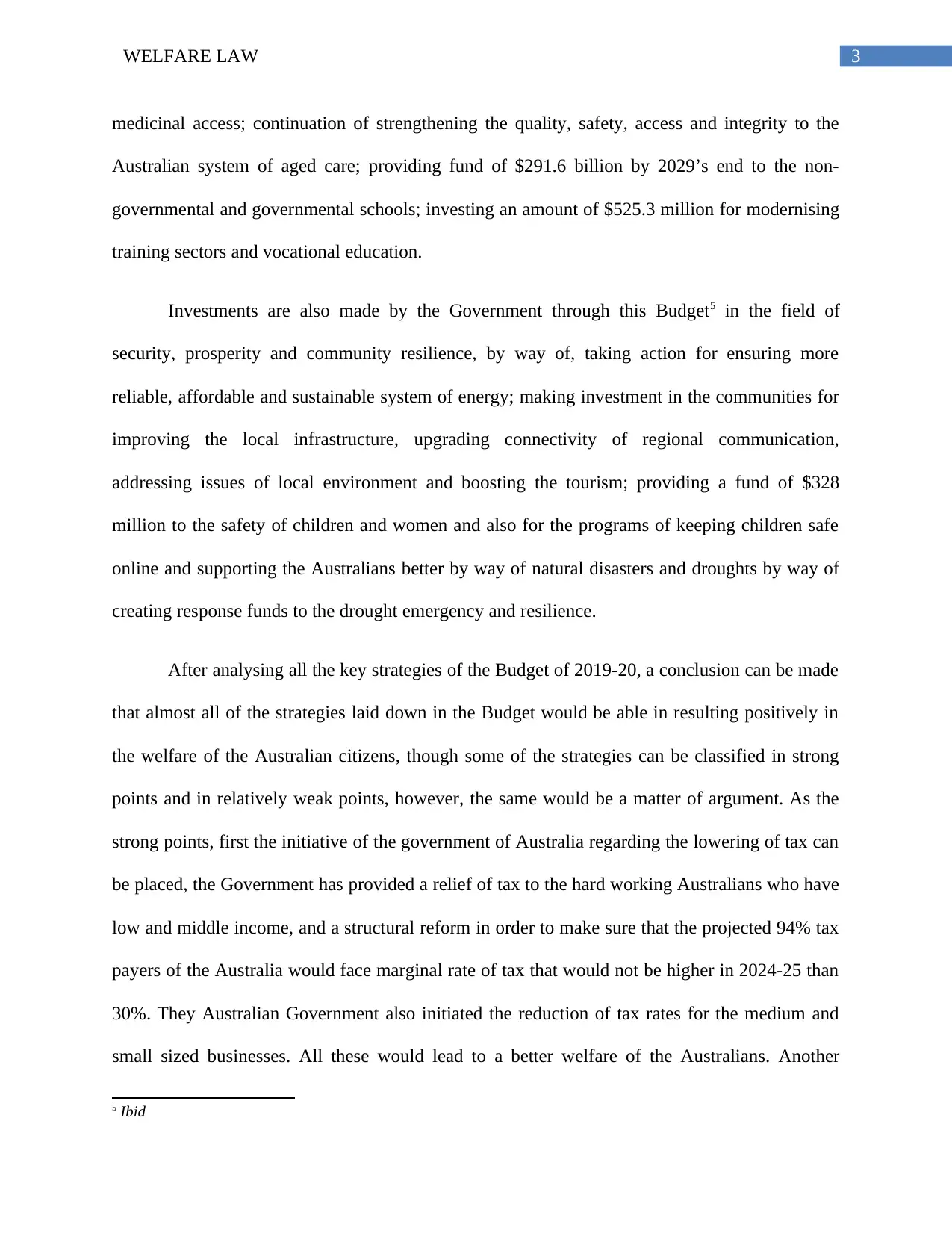
3WELFARE LAW
medicinal access; continuation of strengthening the quality, safety, access and integrity to the
Australian system of aged care; providing fund of $291.6 billion by 2029’s end to the non-
governmental and governmental schools; investing an amount of $525.3 million for modernising
training sectors and vocational education.
Investments are also made by the Government through this Budget5 in the field of
security, prosperity and community resilience, by way of, taking action for ensuring more
reliable, affordable and sustainable system of energy; making investment in the communities for
improving the local infrastructure, upgrading connectivity of regional communication,
addressing issues of local environment and boosting the tourism; providing a fund of $328
million to the safety of children and women and also for the programs of keeping children safe
online and supporting the Australians better by way of natural disasters and droughts by way of
creating response funds to the drought emergency and resilience.
After analysing all the key strategies of the Budget of 2019-20, a conclusion can be made
that almost all of the strategies laid down in the Budget would be able in resulting positively in
the welfare of the Australian citizens, though some of the strategies can be classified in strong
points and in relatively weak points, however, the same would be a matter of argument. As the
strong points, first the initiative of the government of Australia regarding the lowering of tax can
be placed, the Government has provided a relief of tax to the hard working Australians who have
low and middle income, and a structural reform in order to make sure that the projected 94% tax
payers of the Australia would face marginal rate of tax that would not be higher in 2024-25 than
30%. They Australian Government also initiated the reduction of tax rates for the medium and
small sized businesses. All these would lead to a better welfare of the Australians. Another
5 Ibid
medicinal access; continuation of strengthening the quality, safety, access and integrity to the
Australian system of aged care; providing fund of $291.6 billion by 2029’s end to the non-
governmental and governmental schools; investing an amount of $525.3 million for modernising
training sectors and vocational education.
Investments are also made by the Government through this Budget5 in the field of
security, prosperity and community resilience, by way of, taking action for ensuring more
reliable, affordable and sustainable system of energy; making investment in the communities for
improving the local infrastructure, upgrading connectivity of regional communication,
addressing issues of local environment and boosting the tourism; providing a fund of $328
million to the safety of children and women and also for the programs of keeping children safe
online and supporting the Australians better by way of natural disasters and droughts by way of
creating response funds to the drought emergency and resilience.
After analysing all the key strategies of the Budget of 2019-20, a conclusion can be made
that almost all of the strategies laid down in the Budget would be able in resulting positively in
the welfare of the Australian citizens, though some of the strategies can be classified in strong
points and in relatively weak points, however, the same would be a matter of argument. As the
strong points, first the initiative of the government of Australia regarding the lowering of tax can
be placed, the Government has provided a relief of tax to the hard working Australians who have
low and middle income, and a structural reform in order to make sure that the projected 94% tax
payers of the Australia would face marginal rate of tax that would not be higher in 2024-25 than
30%. They Australian Government also initiated the reduction of tax rates for the medium and
small sized businesses. All these would lead to a better welfare of the Australians. Another
5 Ibid
Paraphrase This Document
Need a fresh take? Get an instant paraphrase of this document with our AI Paraphraser
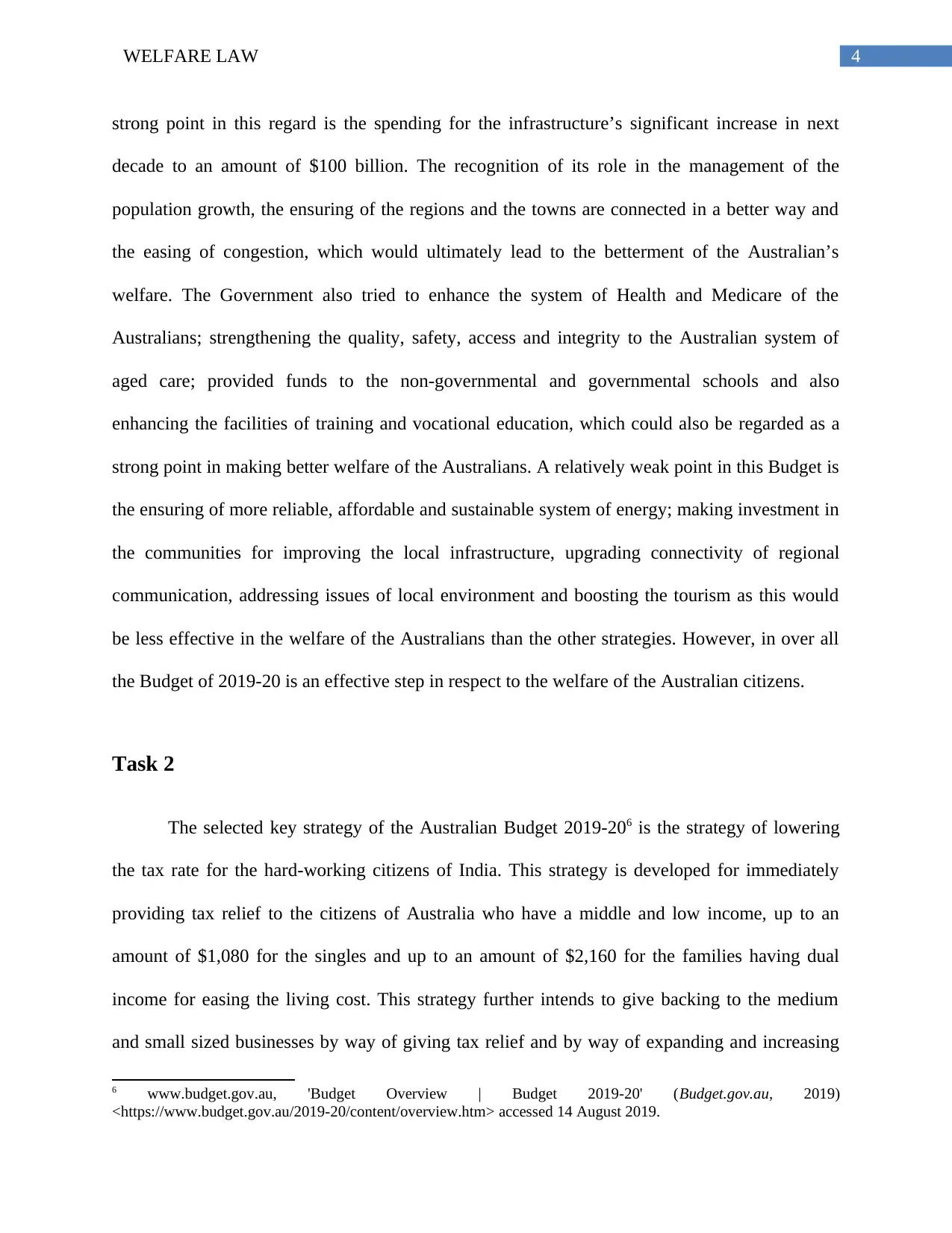
4WELFARE LAW
strong point in this regard is the spending for the infrastructure’s significant increase in next
decade to an amount of $100 billion. The recognition of its role in the management of the
population growth, the ensuring of the regions and the towns are connected in a better way and
the easing of congestion, which would ultimately lead to the betterment of the Australian’s
welfare. The Government also tried to enhance the system of Health and Medicare of the
Australians; strengthening the quality, safety, access and integrity to the Australian system of
aged care; provided funds to the non-governmental and governmental schools and also
enhancing the facilities of training and vocational education, which could also be regarded as a
strong point in making better welfare of the Australians. A relatively weak point in this Budget is
the ensuring of more reliable, affordable and sustainable system of energy; making investment in
the communities for improving the local infrastructure, upgrading connectivity of regional
communication, addressing issues of local environment and boosting the tourism as this would
be less effective in the welfare of the Australians than the other strategies. However, in over all
the Budget of 2019-20 is an effective step in respect to the welfare of the Australian citizens.
Task 2
The selected key strategy of the Australian Budget 2019-206 is the strategy of lowering
the tax rate for the hard-working citizens of India. This strategy is developed for immediately
providing tax relief to the citizens of Australia who have a middle and low income, up to an
amount of $1,080 for the singles and up to an amount of $2,160 for the families having dual
income for easing the living cost. This strategy further intends to give backing to the medium
and small sized businesses by way of giving tax relief and by way of expanding and increasing
6 www.budget.gov.au, 'Budget Overview | Budget 2019-20' (Budget.gov.au, 2019)
<https://www.budget.gov.au/2019-20/content/overview.htm> accessed 14 August 2019.
strong point in this regard is the spending for the infrastructure’s significant increase in next
decade to an amount of $100 billion. The recognition of its role in the management of the
population growth, the ensuring of the regions and the towns are connected in a better way and
the easing of congestion, which would ultimately lead to the betterment of the Australian’s
welfare. The Government also tried to enhance the system of Health and Medicare of the
Australians; strengthening the quality, safety, access and integrity to the Australian system of
aged care; provided funds to the non-governmental and governmental schools and also
enhancing the facilities of training and vocational education, which could also be regarded as a
strong point in making better welfare of the Australians. A relatively weak point in this Budget is
the ensuring of more reliable, affordable and sustainable system of energy; making investment in
the communities for improving the local infrastructure, upgrading connectivity of regional
communication, addressing issues of local environment and boosting the tourism as this would
be less effective in the welfare of the Australians than the other strategies. However, in over all
the Budget of 2019-20 is an effective step in respect to the welfare of the Australian citizens.
Task 2
The selected key strategy of the Australian Budget 2019-206 is the strategy of lowering
the tax rate for the hard-working citizens of India. This strategy is developed for immediately
providing tax relief to the citizens of Australia who have a middle and low income, up to an
amount of $1,080 for the singles and up to an amount of $2,160 for the families having dual
income for easing the living cost. This strategy further intends to give backing to the medium
and small sized businesses by way of giving tax relief and by way of expanding and increasing
6 www.budget.gov.au, 'Budget Overview | Budget 2019-20' (Budget.gov.au, 2019)
<https://www.budget.gov.au/2019-20/content/overview.htm> accessed 14 August 2019.
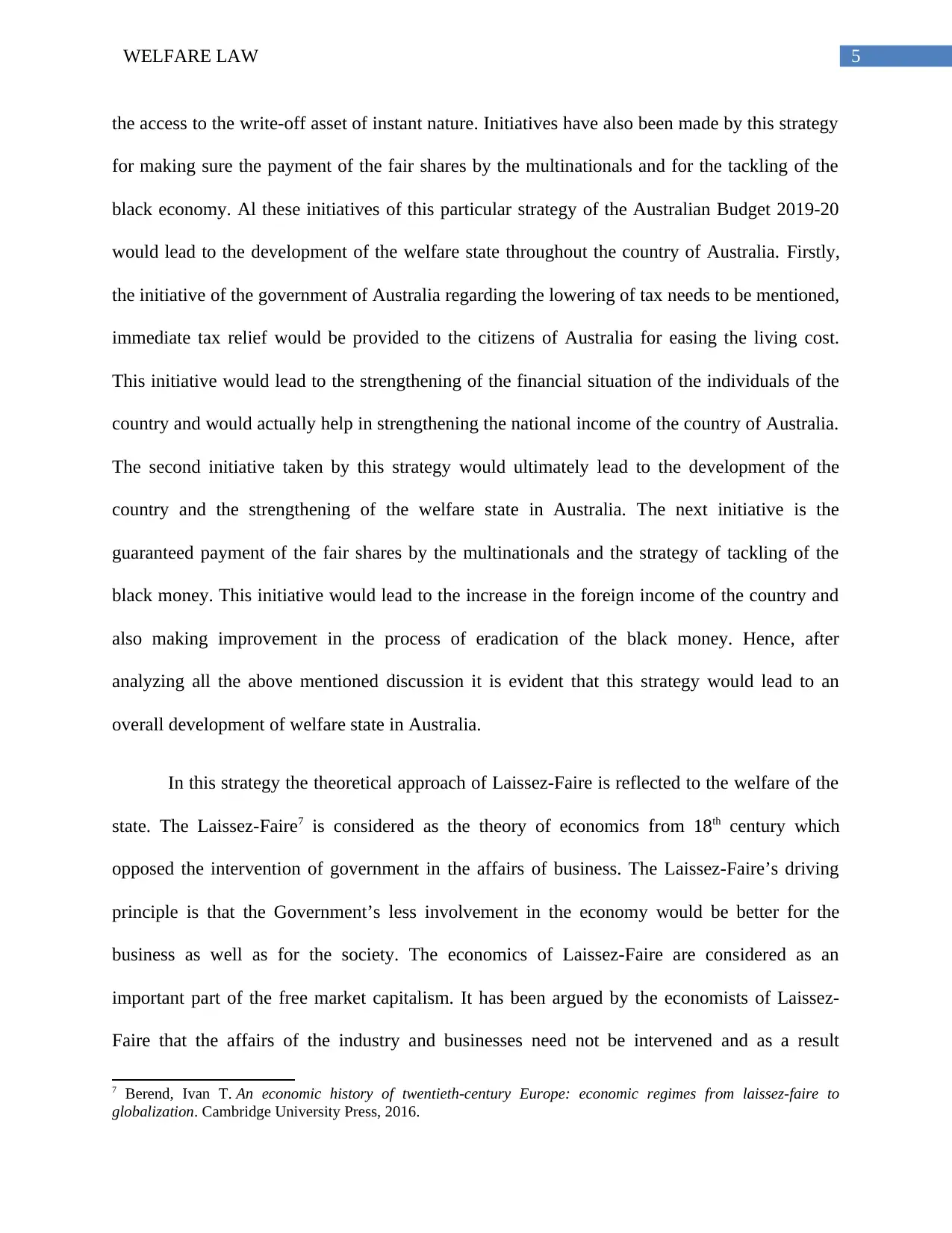
5WELFARE LAW
the access to the write-off asset of instant nature. Initiatives have also been made by this strategy
for making sure the payment of the fair shares by the multinationals and for the tackling of the
black economy. Al these initiatives of this particular strategy of the Australian Budget 2019-20
would lead to the development of the welfare state throughout the country of Australia. Firstly,
the initiative of the government of Australia regarding the lowering of tax needs to be mentioned,
immediate tax relief would be provided to the citizens of Australia for easing the living cost.
This initiative would lead to the strengthening of the financial situation of the individuals of the
country and would actually help in strengthening the national income of the country of Australia.
The second initiative taken by this strategy would ultimately lead to the development of the
country and the strengthening of the welfare state in Australia. The next initiative is the
guaranteed payment of the fair shares by the multinationals and the strategy of tackling of the
black money. This initiative would lead to the increase in the foreign income of the country and
also making improvement in the process of eradication of the black money. Hence, after
analyzing all the above mentioned discussion it is evident that this strategy would lead to an
overall development of welfare state in Australia.
In this strategy the theoretical approach of Laissez-Faire is reflected to the welfare of the
state. The Laissez-Faire7 is considered as the theory of economics from 18th century which
opposed the intervention of government in the affairs of business. The Laissez-Faire’s driving
principle is that the Government’s less involvement in the economy would be better for the
business as well as for the society. The economics of Laissez-Faire are considered as an
important part of the free market capitalism. It has been argued by the economists of Laissez-
Faire that the affairs of the industry and businesses need not be intervened and as a result
7 Berend, Ivan T. An economic history of twentieth-century Europe: economic regimes from laissez-faire to
globalization. Cambridge University Press, 2016.
the access to the write-off asset of instant nature. Initiatives have also been made by this strategy
for making sure the payment of the fair shares by the multinationals and for the tackling of the
black economy. Al these initiatives of this particular strategy of the Australian Budget 2019-20
would lead to the development of the welfare state throughout the country of Australia. Firstly,
the initiative of the government of Australia regarding the lowering of tax needs to be mentioned,
immediate tax relief would be provided to the citizens of Australia for easing the living cost.
This initiative would lead to the strengthening of the financial situation of the individuals of the
country and would actually help in strengthening the national income of the country of Australia.
The second initiative taken by this strategy would ultimately lead to the development of the
country and the strengthening of the welfare state in Australia. The next initiative is the
guaranteed payment of the fair shares by the multinationals and the strategy of tackling of the
black money. This initiative would lead to the increase in the foreign income of the country and
also making improvement in the process of eradication of the black money. Hence, after
analyzing all the above mentioned discussion it is evident that this strategy would lead to an
overall development of welfare state in Australia.
In this strategy the theoretical approach of Laissez-Faire is reflected to the welfare of the
state. The Laissez-Faire7 is considered as the theory of economics from 18th century which
opposed the intervention of government in the affairs of business. The Laissez-Faire’s driving
principle is that the Government’s less involvement in the economy would be better for the
business as well as for the society. The economics of Laissez-Faire are considered as an
important part of the free market capitalism. It has been argued by the economists of Laissez-
Faire that the affairs of the industry and businesses need not be intervened and as a result
7 Berend, Ivan T. An economic history of twentieth-century Europe: economic regimes from laissez-faire to
globalization. Cambridge University Press, 2016.
⊘ This is a preview!⊘
Do you want full access?
Subscribe today to unlock all pages.

Trusted by 1+ million students worldwide
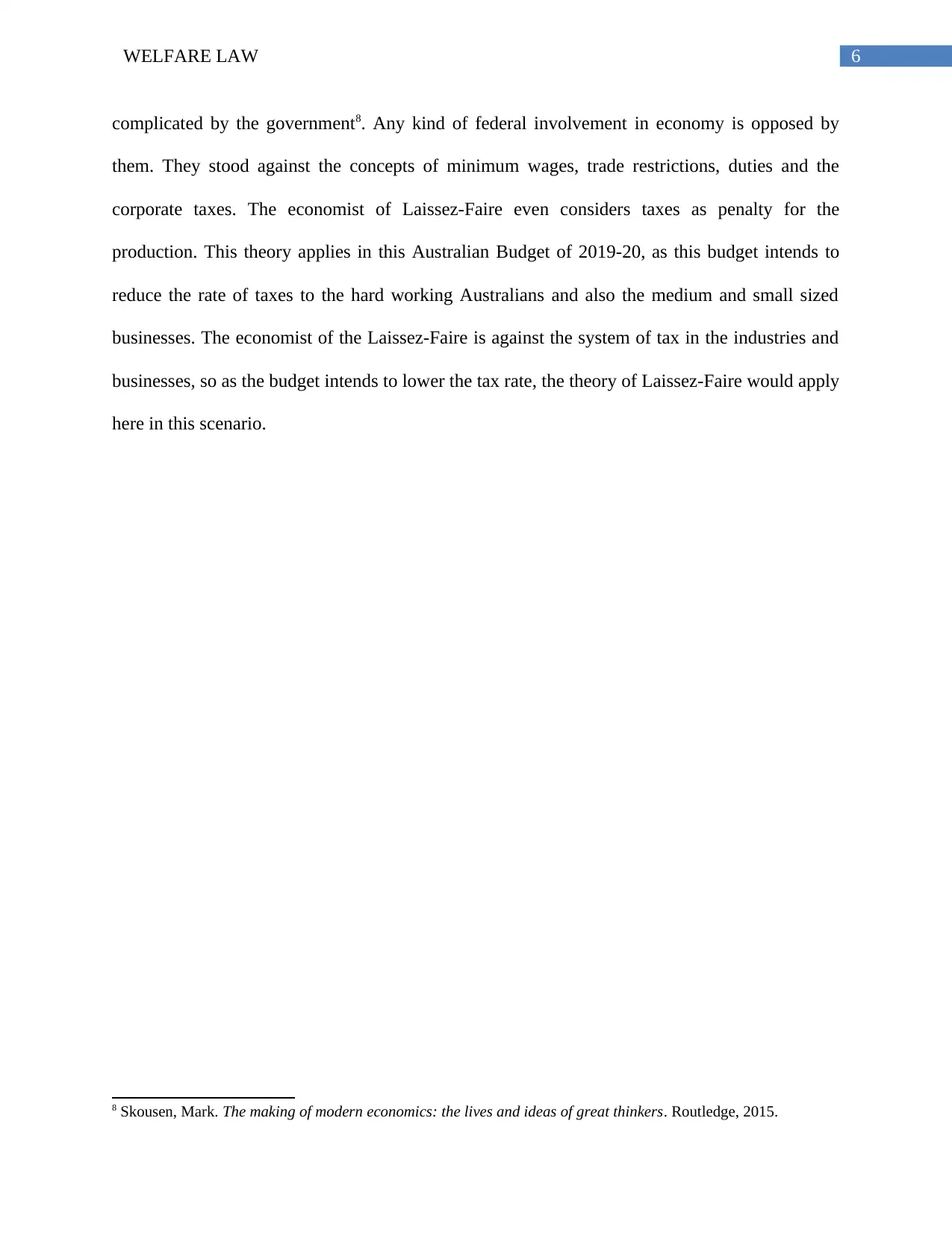
6WELFARE LAW
complicated by the government8. Any kind of federal involvement in economy is opposed by
them. They stood against the concepts of minimum wages, trade restrictions, duties and the
corporate taxes. The economist of Laissez-Faire even considers taxes as penalty for the
production. This theory applies in this Australian Budget of 2019-20, as this budget intends to
reduce the rate of taxes to the hard working Australians and also the medium and small sized
businesses. The economist of the Laissez-Faire is against the system of tax in the industries and
businesses, so as the budget intends to lower the tax rate, the theory of Laissez-Faire would apply
here in this scenario.
8 Skousen, Mark. The making of modern economics: the lives and ideas of great thinkers. Routledge, 2015.
complicated by the government8. Any kind of federal involvement in economy is opposed by
them. They stood against the concepts of minimum wages, trade restrictions, duties and the
corporate taxes. The economist of Laissez-Faire even considers taxes as penalty for the
production. This theory applies in this Australian Budget of 2019-20, as this budget intends to
reduce the rate of taxes to the hard working Australians and also the medium and small sized
businesses. The economist of the Laissez-Faire is against the system of tax in the industries and
businesses, so as the budget intends to lower the tax rate, the theory of Laissez-Faire would apply
here in this scenario.
8 Skousen, Mark. The making of modern economics: the lives and ideas of great thinkers. Routledge, 2015.
Paraphrase This Document
Need a fresh take? Get an instant paraphrase of this document with our AI Paraphraser
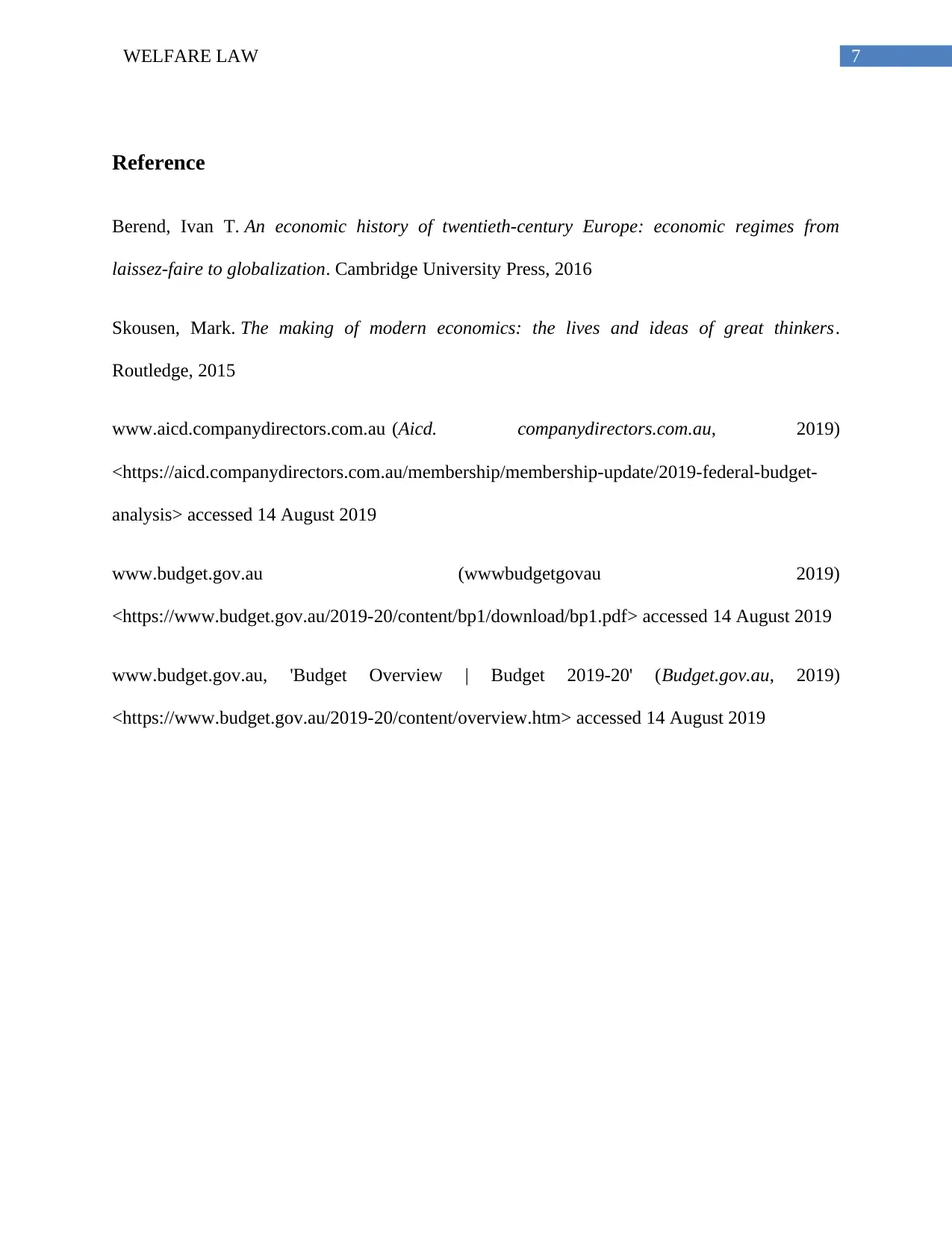
7WELFARE LAW
Reference
Berend, Ivan T. An economic history of twentieth-century Europe: economic regimes from
laissez-faire to globalization. Cambridge University Press, 2016
Skousen, Mark. The making of modern economics: the lives and ideas of great thinkers.
Routledge, 2015
www.aicd.companydirectors.com.au (Aicd. companydirectors.com.au, 2019)
<https://aicd.companydirectors.com.au/membership/membership-update/2019-federal-budget-
analysis> accessed 14 August 2019
www.budget.gov.au (wwwbudgetgovau 2019)
<https://www.budget.gov.au/2019-20/content/bp1/download/bp1.pdf> accessed 14 August 2019
www.budget.gov.au, 'Budget Overview | Budget 2019-20' (Budget.gov.au, 2019)
<https://www.budget.gov.au/2019-20/content/overview.htm> accessed 14 August 2019
Reference
Berend, Ivan T. An economic history of twentieth-century Europe: economic regimes from
laissez-faire to globalization. Cambridge University Press, 2016
Skousen, Mark. The making of modern economics: the lives and ideas of great thinkers.
Routledge, 2015
www.aicd.companydirectors.com.au (Aicd. companydirectors.com.au, 2019)
<https://aicd.companydirectors.com.au/membership/membership-update/2019-federal-budget-
analysis> accessed 14 August 2019
www.budget.gov.au (wwwbudgetgovau 2019)
<https://www.budget.gov.au/2019-20/content/bp1/download/bp1.pdf> accessed 14 August 2019
www.budget.gov.au, 'Budget Overview | Budget 2019-20' (Budget.gov.au, 2019)
<https://www.budget.gov.au/2019-20/content/overview.htm> accessed 14 August 2019
1 out of 8
Related Documents
Your All-in-One AI-Powered Toolkit for Academic Success.
+13062052269
info@desklib.com
Available 24*7 on WhatsApp / Email
![[object Object]](/_next/static/media/star-bottom.7253800d.svg)
Unlock your academic potential
Copyright © 2020–2025 A2Z Services. All Rights Reserved. Developed and managed by ZUCOL.





